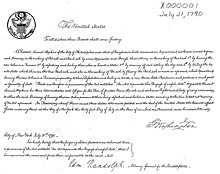Samuel Hopkins (inventor)

Samuel Hopkins (December 9, 1743 – 1818) was an American
The statute did not create a Patent Office. Instead a committee of the Secretary of State, Secretary of War and the Attorney General were authorized to make a decision on the merit of a properly documented petition.
The patent was signed by President George Washington, Attorney General Edmund Randolph, and Secretary of State Thomas Jefferson. The other U.S. patents issued that year were for a new candle-making process and Oliver Evans's flour-milling machinery.
Hopkins also received the first "Canadian" patent from the Parliament of Lower Canada in 1791, issued "by the Governor General in Council to Angus MacDonnel, a Scottish soldier garrisoned at Quebec City, and to Samuel Hopkins, for processes to make potash and soap from wood ash."[4][5][6]
Personal details
Samuel Hopkins, the second child of
Circa 1800, for financial reasons, Hopkins and his wife moved to Rahway, New Jersey, to live with their daughter Sarah and son-in-law William Shotwell. They returned to Philadelphia sometime before Hopkins's death in 1818.
References
- ^ Paynter, Henry M (Fall 1990). "The First Patent". Invention & Technology. Archived from the original on 2018-08-24.
- ISBN 1-887901-13-2.
- ^ "Kids - Time Machine - Historic Press Releases - USPTO". United States Patent and Trademark Office.
- ^ "Learn and Discover: Famous Canadian Patents". Canadian Intellectual Property Office. 2006-11-07. Archived from the original on 2007-02-16.
- ^ Duy, Vic (January 2001). "A Brief History of the Canadian Patent System" (PDF). Canadian Biotechnology Advisory Committee. Archived from the original (PDF) on October 28, 2008.
- ^ White, Michael (January 7, 2007). "Greatest Canadian Invention: Insulin". The Patent Librarian's Notebook.
